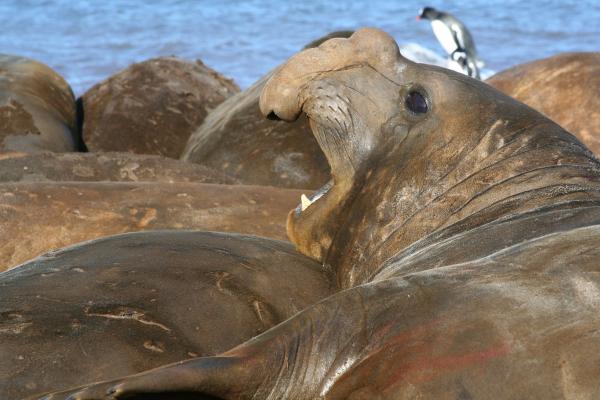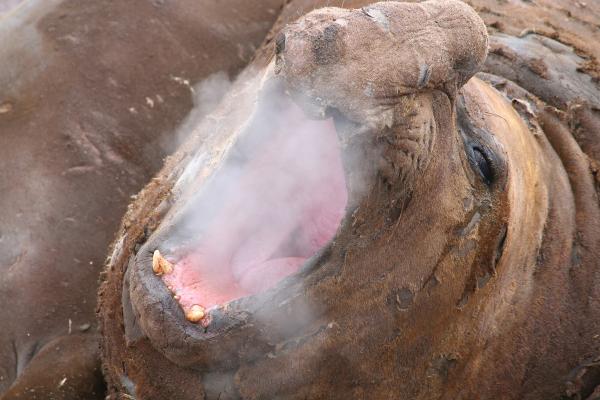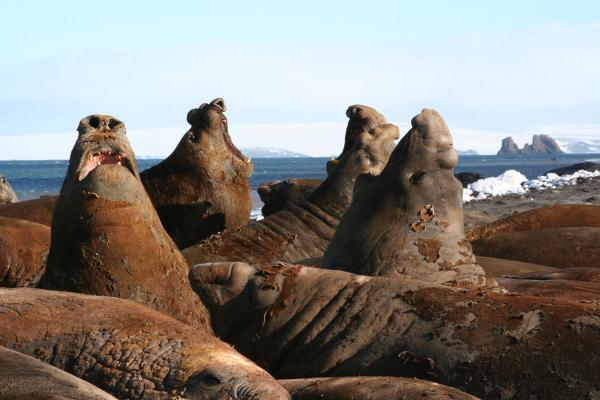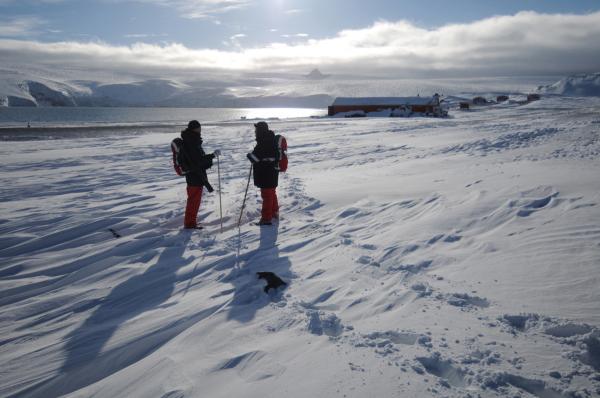Antarctic Seals Go Where Scientists Can't

Gustavo Seal

The bull elephant seal Gustavo here is carrying a transmitter. This seal and others like him are now helping scientists gather research where people cannot go the icy ocean around the South Pole.
During the Antarctic winter, the Southern Ocean is covered with ice, and research vessels cannot sail continuously through it to capture data. These seals are therefore serving as genuine scientific pioneers.
Elephant Seal

On land, elephant seals may seem sedate, but get them in the water and you will see just how capable they really are. During the annual migrations to their oceanic feeding grounds, elephant seals cover thousands of miles, diving down to depths of more than 6,560 feet (2,000 meters) and remaining underwater for spans of more than an hour.
Every year at this time, the males of the only reproduction colony of the southern elephant seal in the Antarctic come to molt their fur at the South Shetland Islands, a group that also includes King George Island. The scientists from the Alfred Wegener Institute took advantage of this narrow time window to tag some of the animals with satellite transmitters.
Gustavo Seal

Gustavo is an imposing bull elephant seal that weighs 3 tons and measures 13 feet (4 meters) in length. He belongs to a group of 14 animals serving as scientific assistants for researchers at the Alfred Wegener Institute in Bremerhaven, Germany.
Seal Transmitter

A state-of-the-art satellite transmitter is fixed with a special adhesive on the short hairs near this elephant seal's head. When a seal with a transmitter dives, it collects data, even under the ice, and when it reappears on the surface again to breathe, the recorded package is sent to a satellite that passes on the information.
Once molting is over after three weeks, the bulls return to their migratory life and do not return to land until six months later, when they mate with the females in the Antarctic spring. With the next molting, the transmitter will fall off with good luck, the transmitter will continuously transfer data until then for a year.
Seal Tagging

At the beginning of the Antarctic winter, from March to April, weather on King George Island, where the seals are tagged, can be rather uncomfortable. Still, researchers brave the harsh conditions to tag elephant seals.
Seal Bulls

"We have just returned from the Antarctic Peninsula and still have fresh impressions of the incredible experience when you have numerous elephant seal bulls with their loud deep roar in front of you," said researcher Joachim Plötz. "Imagine attaching a satellite transmitter the size of your palm to some of these huge creatures."
Elephant Seal Call

The call of an elephant seal here sounds like a loud deep roar. In the ocean, the satellite tags scientists are affixing on them will call out for them during a tagged seal's voyages across the Southern Ocean, its transmitter will send not only its geographic position and diving depth, but also data on water temperature and salt concentration. This will help scientists draw conclusions regarding the creatures living in such waters.
"Elephant seals mainly feed on fish and squid," researcher Horst Bornemann explained. "They lead a nomadic life in the ice desert of the Antarctic Ocean and are always looking for regions with ample prey."
Get the world’s most fascinating discoveries delivered straight to your inbox.
Seal Migration Scientists

In the coming months, marine biologists Joachim Plötz (right) and Horst Bornemann (left) can now follow Gustavo and other elephant seals from their desks in Germany. By following seal migrations via satellite, the scientists can figure out how productive zones with exceptionally high numbers of fish and squid occurring in the Southern Ocean are distributed in space and change over time, as well as what depths and ocean conditions are linked with good supplies of food.
When the next molting takes place, the microelectronics, developed by the Scottish Sea Mammal Research Unit, will then fall off. Even though the transmitters only hold out for a year, the data will be highly sought after in the following months. Information from this German-Argentinean-South African joint project will be made available for scientific ventures around the world.



